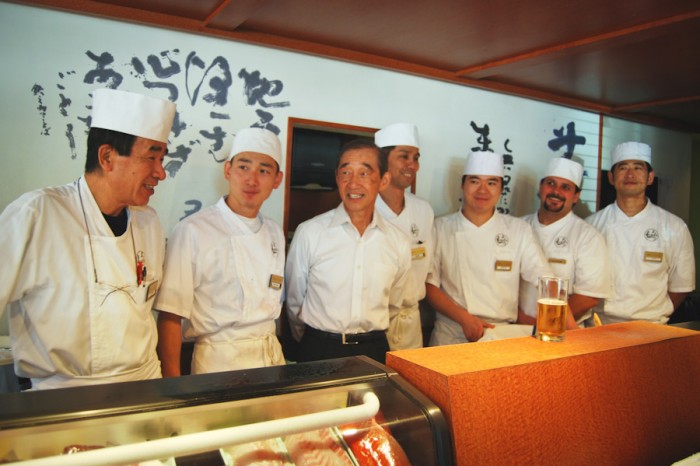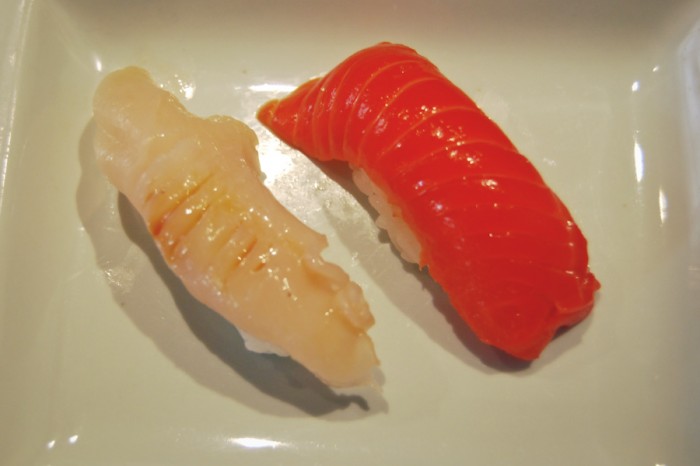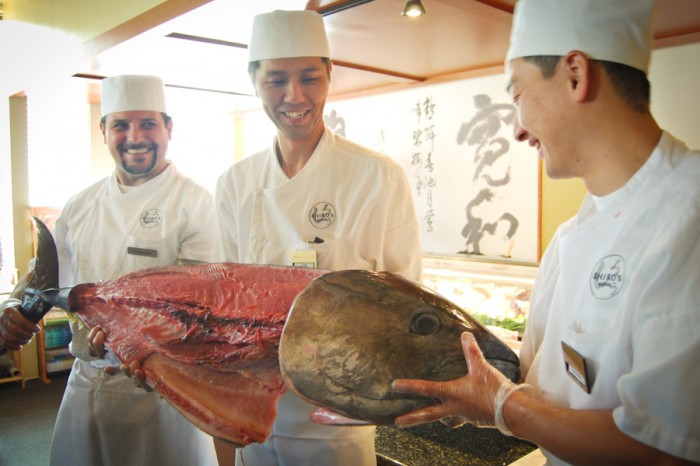
At Shiro’s Sushi Restaurant in Belltown, it only takes chef Jun Takai a matter of minutes to butcher a 75-pound bluefin tuna.
But the precious $2,000 fish isn’t about to be turned into the likes of a spicy tuna roll drenched in Sriracha mayo.
These days, sushi can come fried in tempura batter, stuffed with cream cheese or even topped with steak tartare. But that Western style of sushi is a huge departure from traditional Japanese cuisine.
A traditionalist like Shiro Kashiba, founder and former chef at Shiro’s Sushi Restaurant, says that hybridization isn’t necessarily bad thing — it just isn’t what he’s into.
“Sushi is a culture and we try to keep that traditional culture, but there’s nothing wrong with that [hybrid] sushi. It’s just different,” said Kashiba, during a media event last week to celebrate the celebrated restaurant’s 20th anniversary and introduce new chefs.
I’m glad chef Kashiba is open-minded, but I can’t say I agree. Just thinking about those tacky-textured, cream cheese-filled “Seattle rolls” make my stomach turn. What are they hiding behind all those extra ingredients?
Sushi restaurants began opening in the U.S. in the decade following World War II and By the 1970s, they were taking the United States by storm. Western-style joints hybridized sushi and popularized using mayonnaise, avocado and other non-traditional ingredients in their recipes to appeal to American tastes.
Although hybridized sushi continues to boom in the States, traditional Japanese cuisine is making a comeback, Kashiba said. He attributes some of that renewed interest to the massive success of the 2011 documentary Jiro Dreams of Sushi. The film follows now-world-famous sushi chef Jiro Ono, with whom Kashiba apprenticed in Tokyo during the 1960s.
Before retiring from his post as head of the kitchen at Shiro’s last April, Kashiba had spent the last 20 years showcasing traditional Japanese Edomae sushi. The Edomae style was born in the 1800s during the Edo-period in Japan. Edo is the old name for Tokyo and mae means “in front,” which explains from where the fish were sourced: Tokyo Bay.

The cuisine is one born out of necessity. Modern refrigeration didn’t exist yet and as a result, fish needed to be consumed soon after it was caught. To preserve the meat for safe consumption, chefs used soy sauce marinades or cured fish in salt and vinegar. In the 19th century, Edomae sushi was a hit with city laborers who needed to eat fast and get back to work.
Refrigeration is ubiquitous today, but the preparation remains similar. Instead of using wasabi, soy sauce or vinegar marinades as a preservative, they are now brushed over the slices of fish for flavor. Each slice is then draped over a small portion of lightly seasoned short grain rice.
These traditional preparation techniques highlight the taste of the seafood instead of disguising fish flavor with mayo and other ingredients that were once unavailable in Japan. Because if you take a bite and can’t taste the fish, you’re not doing sushi justice.
“The American palate has changed from [the original] sushi restaurant hybrids and it’s going back to the traditional style,” said chef Aaron Pate another chef at Shiro’s. “[With Edomae], you can’t hide the freshness of the fish.”
While taste and freshness are high priorities at Shiro’s, the business is also holding to Edomae traditions by using local, sustainably caught seafood. Currently, the menu is stocked with seasonal offerings from Oregon and the Puget Sound including geoduck, clams, smelt, tuna and salmon. Depending on local availability, other fish such as mackerel, Hokkaido scallops and tuna (like the 75-pounder mentioned above) are sourced from Japan.
“Thirty years ago, if you put pasta and some kind of red sauce together, you had spaghetti. Now, people are more into the details and care where [the ingredients] came from,” said Yasuko Nakajima, a company representative for Shrio’s.
Although Shiro’s tries to keep it local and sustainable when it comes their ingredients, some popular preparations are tough to pull off with a clear conscience. The bluefin tuna Takai carved up last week was part of a new Japanese university program to egg-raise the precious species, which been decimated by global demand for sushi. But even that practice is controversial and has environmentally-minded sushi chefs in an uproar.

“If you got the bluefin from halfway around the world, that isn’t the [Japanese] tradition in any way. Tradition tells you to eat what is available close by,” said Hajime Sato, chef and owner of Mashiko in West Seattle.
He says his sushi bar has been entirely sustainable since 2009, even going to far as to only serve octopus when it’s caught accidentally by their suppliers targeting other fish.
So why did he do it?
“People don’t go out shooting cheetahs and elephants to eat the meat because they know they are endangered,” said Sato, explaining his decision to go sustainable “So you don’t eat them, but you’ll go back and eat bluefin tuna? I don’t understand that.”
Egg-raising tuna, he said, is essentially the same thing as farming tuna, which is fraught with environmental costs. Once the tuna are big enough, each one must be fed huge amounts of feeder fish per day, decimating the population of smaller fish.
“People need to know more about what’s going on in the ocean. They only see the ocean as a big mystery,” said the chef. “If we keep going like this, we’re not going to have fish in 20 years.”
So what to do if you want to keep enjoying sushi well into your golden years? Sato suggests consumers should be open minded about trying new things, and chefs should embrace the true sushi tradition — serving only fish that are local and in season.
Drop the California rolls and try these more traditional Seattle sushi restaurants:
-
Maneki is an old-school International District favorite serving up fresh sashimi and beyond.
-
Musashi’s in Wallingford spot offers great custom Chirashi bowls (sashimi chunks over sushi rice). Skip the sushi rolls.
-
Mashiko lets you chow down on sustainable sushi. They offer some wackier hybrid rolls, too.
- Shiro’s has a new team of chefs but a time honored tradition. Make a reservation or be ready to wait in line.
If you’re dying for something a little different, here are some of the best of the Western hybrids:
-
Japonessa Sushi Cocina in the heart of downtown tops rolls with everything from chipotle sauces to sirloin steak.
-
Chiso in Fremont for a great selection of rolls, including eel and avocado.
-
Gaba Sushi in Pioneer Square restaurant uses sprouted brown rice as the base for their sushi rolls.
Stay informed by following sites like the Monterey Bay Aquarium Seafood Watch to understand what seafood is endangered before it ends up on your plate.

